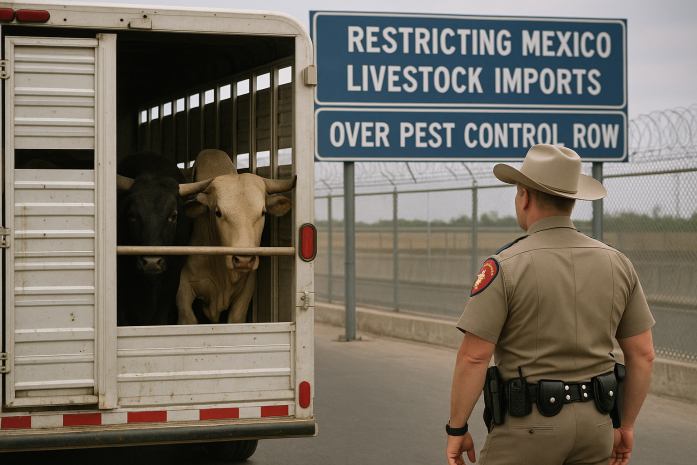US Blocks Imports of Mexico Livestock Over Pest Control Dispute
The US restricts livestock imports from Mexico over pest control concerns, sparking trade tensions and impacting ranchers and beef supply chains.

Introduction
The United States has restricted livestock imports from parts of Mexico after growing distrust of pest control practices. This move, as much a function of biosecurity as anything, has triggered a tidal wave of economic and political backlash on both sides of the border. With billions of dollars hanging in the balance in the livestock industry, the ramifications of the move go far beyond farm gates.
What Triggers the Conflict?
Underlying the issue is a dispute regarding pest inspection and extermination procedures. The US Department of Agriculture (USDA) raised an eyebrow when recurring discrepancies were found in inspections within northern Mexican states. The essence? Variations in the methods by which pests, specifically ticks that are infamous for spreading deadly diseases like bovine babesiosis, are being kept in check.
Background on Livestock Trade
Mexico is a significant cattle supplier to the US. The US imported over one million head of cattle from Mexico in 2023 alone. This cross-border commerce not only supports meat processors in the US but also ranchers across thousands of Mexico.
The Pest Control Problem
So why is there such a fuss about pests? Certain livestock pests, such as the cattle fever tick, pose a serious threat to US agriculture. They can spread extremely rapidly and infect huge herds, resulting in enormous economic losses.
US Standards vs. Mexico's Measures
The US has strict regulations to keep such pests out of its environment. The officials assert that inspection procedures in some Mexican states have not been up to these standards consistently, requiring measures to be taken.
USDA's Response
As a response to pest control concerns, the USDA temporarily suspended inspections in Mexican areas of concern. This operationally stops livestock exports from the areas to the US, as animals cannot be exported out of those areas to the US without certification.
Regions Affected
The suspension primarily affects the northern Mexican states of Sonora, Chihuahua, and Durango. These are major producers of the livestock export sector, so the impact of the decision is significant.
Mexico's Reaction
Mexican officials were quick to respond, deeming the US action as abrupt and unsubstantiated. The Mexican government is now in negotiations with its US counterparts to achieve a diplomatic resolution to the crisis and restore trade flows in as short a time as possible.
Effect on Ranchers
anchers in the area, who rely heavily on American exports, are groaning under the pressure. Many of them are preparing for monetary losses, with no quick alternative markets to sell their products.
Effect on the US Market
While the ban will be aimed at protecting US animals, it can also delay domestic meat supplies. Temporary disruption in supplies may lift beef prices on some markets, especially those based on heavily dependent states on Mexican imports.
The Role of Bi-National Coordination
This situation highlights the immediate need for coordinated pest control measures and codified inspection systems. Both nations have long cooperated through bi-national agreements—any recent tensions suggest trust and coordination need rebooting.
International Trade Laws Involved
The furor also impacted World Trade Organization (WTO) trade commitments. Sanitary and Phytosanitary (SPS) measures allow countries to have health rules, but such rules must be backed by science.
How This Affects Consumers
Customers will begin to feel the difference in beef prices or availability in a few weeks. Though there is no public health threat, anxiety over food safety and pest control might influence purchasing patterns.
Expert Views
Farm professionals view this stalemate as an eye-opener for a stronger cross-border pest management infrastructure. Pest management experts underscore the importance of regular, science-based processes on both sides for establishing trust and security.
Potential Solutions
In the coming days, the two countries are expected to devise a template for uniform inspections. Third-party accreditation, bilateral audits, and openness can be the support pillars of new agreements. Expectations are of an agreement that satisfies biosecurity without mangling commerce.
Conclusion
This restriction on livestock imports is not about pests—it's about standards, trust, and finding a middle ground between protecting agriculture and facilitating economic trade. While the path to solution may take time, it's clear that Mexico and the US both need to come together to develop a plan that is centered around safety and sustainability. Until that happens, ranchers, traders, and consumers alike have to wait for answers.
FAQs
1. Which livestock are affected?
Primarily cattle from north Mexican states like Sonora, Chihuahua, and Durango.
2. Why is pest control such a big issue?
Uncontrolled pests can lead to the transmission of diseases like cattle fever that can jeopardize the US livestock industry.
3. How long are the restrictions being applied for?
No time frame has been provided yet—it's dependent on Mexico resolving US grievances relating to pest control methods.
4. Is the consumer in the US at risk?
No short-term threat to consumers, but prices of beef might be affected by supply disruptions.
5. In the meantime, what can ranchers do?
Numerous ones are trying to cooperate with Mexican officials to be eligible for inspection and seek out alternative markets temporarily.













